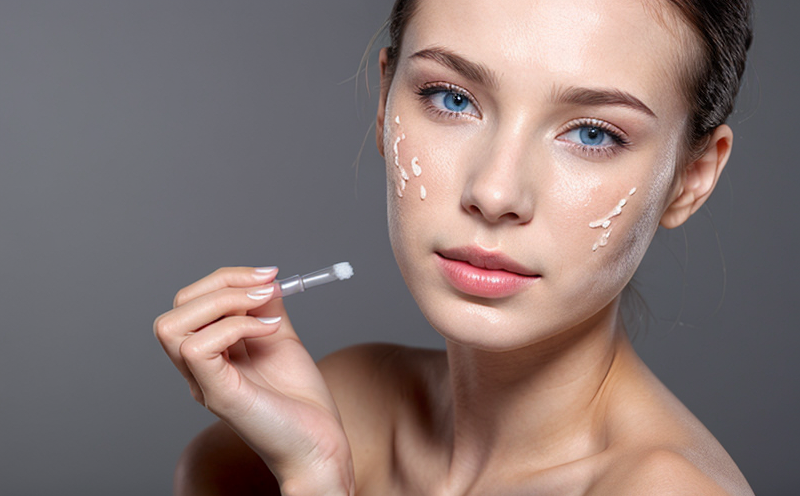Sensitization Testing for Sunscreen Active Ingredients
Testing sunscreen active ingredients for sensitization potential is crucial in ensuring consumer safety and compliance with regulatory standards. Sensitization testing assesses whether a chemical, such as an active ingredient in sunscreens, can cause allergic reactions or irritations when applied to the skin.
The importance of this testing cannot be overstated given the increasing demand for safer cosmetic products. The European Union, among other regions, has stringent regulations on allergens and sensitizers in cosmetics. This necessitates thorough testing to ensure compliance with these standards.
The most commonly used standard for assessing sensitization potential is EN 15006:2018, which outlines the procedure for determining the skin sensitizing potential of chemicals. This test is performed using human epidermal cells derived from donors or reconstructed human epidermis (RHE). The test assesses changes in cell viability and cytokine production as indicators of sensitization.
Another critical aspect of this testing involves ensuring that the active ingredient can withstand the rigors of sunscreen formulations without compromising its efficacy. This includes maintaining photostability, which is essential for preventing degradation under UV light conditions. Photostability testing ensures that the active ingredient remains effective throughout the product's shelf life.
Furthermore, the compatibility of the active ingredient with other components in the sunscreen formulation must be evaluated. This involves assessing how different ingredients interact and whether any adverse reactions or changes occur during blending and processing stages. Ensuring compatibility helps maintain the overall performance and stability of the final product.
The testing process typically begins with a detailed review of the chemical structure and known sensitizing potential of the active ingredient. This information is crucial for selecting appropriate test methods and ensuring that the tests are relevant to real-world conditions. Once selected, the active ingredient is incorporated into a sunscreen formulation according to standard protocols.
The formulated sample undergoes rigorous testing using various analytical techniques such as high-performance liquid chromatography (HPLC), Fourier-transform infrared spectroscopy (FTIR), and nuclear magnetic resonance (NMR) to confirm its composition. These analyses help verify that the sunscreen contains the correct active ingredients in the specified concentrations.
The formulated sample is then subjected to a series of tests designed to evaluate its photostability, water resistance, and overall effectiveness. Photostability testing assesses how well the sunscreen maintains its properties over time when exposed to UV light. Water resistance testing evaluates the sunscreen's ability to remain effective after exposure to water.
Once the formulated sample passes all these preliminary tests, it is ready for sensitization testing. This involves applying the sunscreen formulation to human epidermal cells or RHE models and monitoring any changes in cell viability over time. Any significant decrease in cell viability may indicate a sensitizing effect.
The results of this test are compared against control samples to determine whether the active ingredient exhibits sensitizing properties. If sensitization is detected, further investigations may be conducted to identify potential causes and mitigate risks. This could involve modifying the formulation or selecting alternative ingredients with lower sensitizing potentials.
Eurolab Advantages
- Comprehensive expertise in skin irritation testing for cosmetic products
- Accurate and reliable test results aligned with international standards
- State-of-the-art facilities equipped with advanced analytical instruments
- Dedicated team of experienced scientists and technicians
- Commitment to ensuring consumer safety and compliance with regulatory requirements
Why Choose This Test
- Ensures product safety for consumers by identifying potential allergens early in the development process
- Facilitates compliance with European Union and other global regulations on cosmetic ingredients
- Enhances brand reputation through responsible sourcing of active ingredients
- Maintains consumer trust by providing transparent information about product safety
Customer Impact and Satisfaction
The success stories of our clients demonstrate the value we bring to their businesses. By ensuring that sunscreen active ingredients meet rigorous sensitization testing standards, our customers can rest assured that their products are safe for consumers.
Our comprehensive approach to skin irritation and sensitization testing has helped multiple companies avoid costly recalls and negative publicity associated with unsafe cosmetic products. This not only protects the brand's reputation but also fosters customer loyalty and satisfaction.
We pride ourselves on delivering accurate, reliable results that help our customers make informed decisions about their product formulations. Our commitment to excellence ensures that every test is conducted according to the highest standards, providing peace of mind for both manufacturers and consumers alike.





